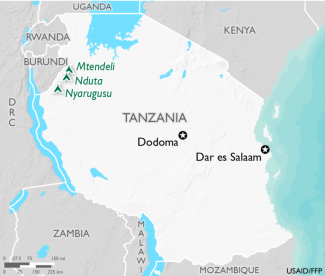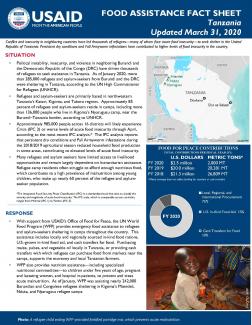March 31, 2020
Conflict and insecurity in neighboring countries have resulted in thousands of refugees seeking shelter in Tanzania. Many refugees in the country continue to face acute food insecurity and remain in need of emergency food assistance.
Situation
- Political instability, insecurity, and violence in neighboring Burundi and the Democratic Republic of the Congo (DRC) have driven thousands of refugees to seek assistance in Tanzania. As of January 2020, more than 285,000 refugees and asylum-seekers from Burundi and the DRC were sheltering in Tanzania, according to the UN High Commissioner for Refugees (UNHCR).
- Refugees and asylum-seekers are primarily based in northwestern Tanzania’s Katavi, Kigoma, and Tabora regions. Approximately 85 percent of refugees and asylum-seekers reside in camps, including more than 136,000 people who live in Kigoma’s Nyarugusu camp, near the Burundi–Tanzania border, according to UNHCR.
- Approximately 985,000 people across 16 districts will likely experience Crisis (IPC 3) or worse levels of acute food insecurity through April, according to the most recent IPC analysis.* The IPC analysis reports that persistent dry conditions and Fall Armyworm infestations during the 2018/2019 agricultural season reduced household food production in some areas, contributing to elevated levels of acute food insecurity.
- Many refugees and asylum seekers have limited access to livelihood opportunities and remain largely dependent on humanitarian assistance. Refugee camp residents often struggle to afford enough nutritious food, which contributes to a high prevalence of malnutrition among young children, who make up nearly 60 percent of the refugee and asylum-seeker population.
*The Integrated Food Security Phase Classification (IPC) is a standardized tool that aims to classify the severity and magnitude of acute food insecurity. The IPC scale, which is comparable across countries, ranges from Minimal (IPC 1) to Famine (IPC 5).
Response
- With support from USAID’s Office of Food for Peace, the UN World Food Program (WFP) provides emergency food assistance to refugees and asylum-seekers sheltering in camps throughout the country. This assistance includes locally and regionally sourced in-kind food rations, U.S.-grown in-kind food aid, and cash transfers for food. Purchasing maize, pulses, and vegetable oil locally in Tanzania, or providing cash transfers with which refugees can purchase food from markets near the camps, supports the economy and local Tanzanian farmers.
- WFP also provides nutrition assistance—including specialized nutritional commodities—to children under five years of age, pregnant and lactating women, and hospital in-patients, to prevent and treat acute malnutrition. As of January, WFP was assisting nearly 242,000 Burundian and Congolese refugees sheltering in Kigoma’s Mtendeli, Nduta, and Nyarugusu refugee camps.
Food for Peace Contributions
Total Contributions:
| U.S. Dollars | Metric Tons | |
|---|---|---|
| Fiscal Year 2020 | $2.5 million | 2,000 MT |
| Fiscal Year 2019 | $20.0 million | 20,281 MT |
| Fiscal Year 2018 | $21.3 million | 26,809 MT |
* Metric tonnage does not reflect funding for vouchers or cash transfers
Related Resources


